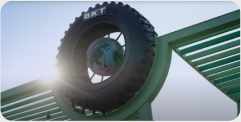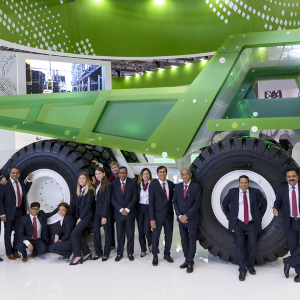How to minimize the effects of mismatched tires on your earthmoving machinery? Find out our suggestions to avoid accelerated tire wear and equipment damage.
Nowadays, heavy equipment is a big expense in construction and mining operations. The million dollar question is: how to minimize the effects of mismatched tires on your loaders, articulated dump trucks, rigid haul trucks, motor graders, scrapers and other pneumatic tired equipment. Let’s highlight a few aspects and offer some suggestions on the matter. Please remember that we are always referring to tires that are properly inflated for the loads applied.

It is widely known that tire wear results in changes to the OD (outside diameter, see illustration on the right) of each tire. As a result of this wear, tires can become mismatched (not the same OD), and this can lead to accelerated tire wear and equipment damage.
Don’t forget the primary importance of tires on drive axles in this regard. They must be matched for OD (outside diameter)/circumference to avoid tire and drive train damage. Here are a few situations which can lead to tire OD mismatch:
- Mixing new and worn tires.
- Mixing tires with different tread designs or tread depths on the same vehicle.
- Mixing tires from different manufacturers on the same vehicle.
- Mixing tires of different construction (bias/radial).

Listen up, any of these situations can result in the mismatched tires working against each other! To gain a better understanding, consider that the drive train is designed to rotate drive tires at compatible speeds. Having mismatched tires on the same axle (see illustration on the left) means that the smaller tire needs to rotate faster than the larger tire to cover the same distance. The drive train, however, is designed to rotate the drive tires to work together, not against each other. So, mismatched tire OD's/circumference will result in excess and premature tire and drive train wear.
Mixing new and worn tires
If all tires are matched for design and manufacturer, mounted concurrently, with the recommended inflation pressure, and have equal service time, the tread wear and resultant tire OD should remain similar and within guidelines. The best thing you can do to maximize tread wear life and produce the most even possible wear is to follow a tire rotation program prescribed by your servicing dealer.
If you can’t maintain tire OD's within acceptable tolerances, this will result in excessive, premature tire and drive train wear. Mismatched tire OD's may also lead to increased fuel usage, reduced productivity, and compromised vehicle handling. The reasons are clear:
- Increased fuel usage because the smaller tire is essentially being dragged and it takes more energy to move the vehicle.
- Reduced productivity because compromised handling can slow the vehicle.
Let us say it again. A tire rotation program is really essential.
Hoping that you have found this information useful so far, in our next post we are going to tell you something about “Matching tire OD on duals”. Stay tuned!





